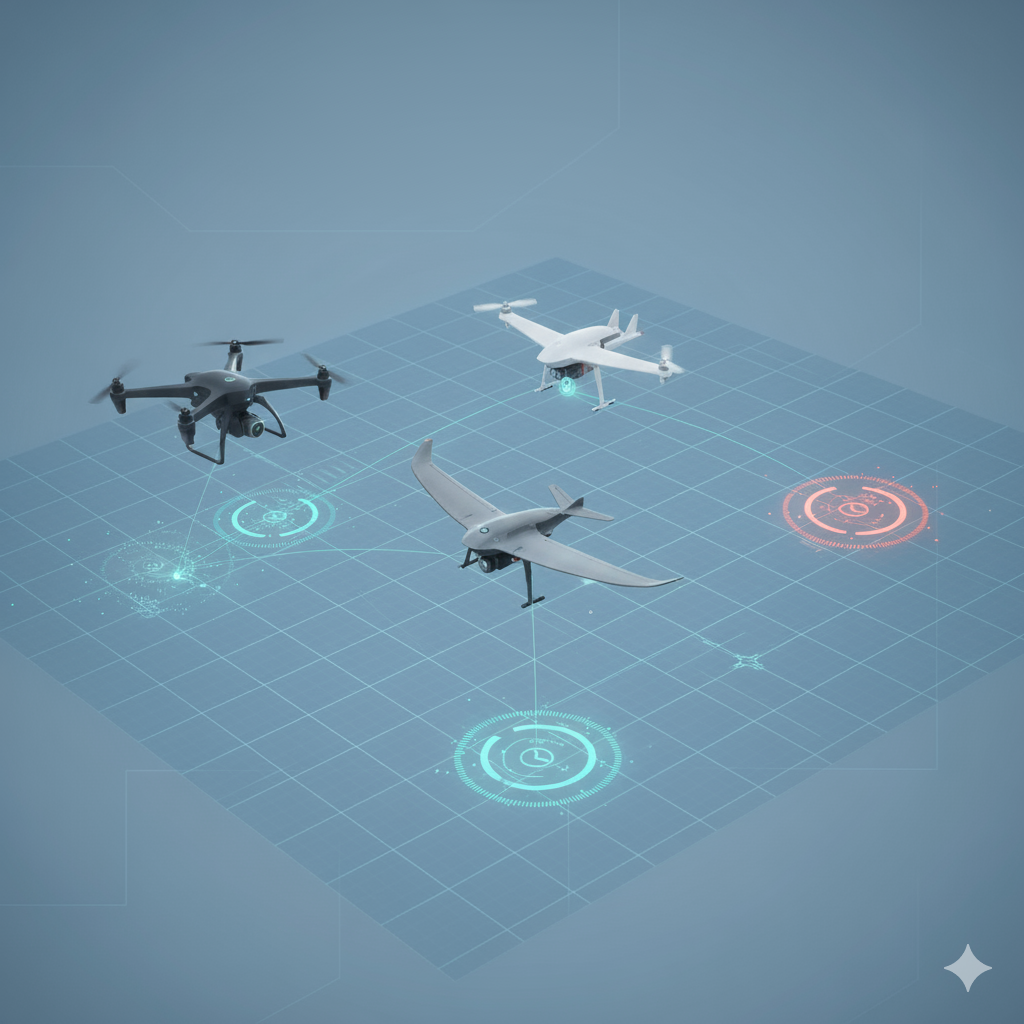In multi-agent systems, assigning tasks under strict timing constraints isn't a scheduling afterthought—it defines mission feasibility. Whether coordinating UAV swarms for time-sensitive reconnaissance, orchestrating industrial robots on assembly lines with microsecond precision, or managing logistics fleets under delivery windows, the difference between success and failure is measured in temporal accuracy.
This blog explores the algorithmic foundations, operational realities, and emerging solutions for timing-constrained assignment in environments where static planning breaks down and centralized control cannot scale.
Understanding Timing-Constrained Assignment
Timing-constrained assignment ensures autonomous agents complete tasks within strict deadlines. While it may seem simple to assign N agents to M tasks, real-world factors like task durations, travel times, and communication delays make it complex. Timing is the main constraint, not an afterthought.
The task completion rate, the percentage of on-time tasks is the true measure of success. In disaster relief or defense missions, late tasks are failures, no matter how elegant the algorithm.
Static planning struggles under real conditions. Communication delays, obstacles, and sensor errors quickly break deterministic models. Centralized approaches often fail in asynchronous or bandwidth-limited environments, highlighting the need for algorithms that handle temporal dynamics effectively.
Core Algorithmic Approaches
This section summarizes the main algorithms for timing-constrained task assignment, from fast heuristics to optimization and learning-based methods. Each balances speed, accuracy, and adaptability differently, revealing trade-offs in real-world multi-agent missions.
Greedy Algorithms
Greedy methods make fast, local decisions based on task urgency or agent availability. Lightweight (O(N log N)) and suitable for real-time use, they can be short-sighted: assigning the nearest agent to an urgent task might block it from a later, tighter-constrained one, trading short-term efficiency for long-term performance.
Optimization-Based Methods (MILP)
Mixed-Integer Linear Programming models timing constraints mathematically to find globally optimal allocations. While theoretically ideal, MILP scales poorly—complexity grows as O(M × N × T). Large-scale missions make real-time execution infeasible; a plan computed in hours may arrive too late.
Market-Based Mechanisms
Tasks are assigned via auctions. Agents bid using local cost functions reflecting travel time, capability, and opportunity cost. Consensus-Based Bundle Algorithms (CBBA) can converge without central control but rely on stable communication and static task sets. In dynamic environments, synchronization overhead often reintroduces centralization.
Reinforcement Learning (RL)
Multi-agent RL teaches coordination through simulation. It performs well in structured scenarios but struggles under real-world uncertainty, often exploiting simulation quirks rather than learning robust, adaptable strategies.
Distributed and Hybrid Approaches
Weighted-cost distributed methods improve greedy performance but still assume near-static conditions. Real missions are dynamic: tasks arrive asynchronously, priorities shift mid-flight, and agent performance evolves in real time. Steady-state algorithms cannot keep pace, underscoring the need for adaptive, timing-aware solutions.
Real-World Applications
Timing-constrained assignment impacts a wide range of multi-agent missions. Here’s how it plays out in different domains:
UAV Operations:
UAV swarm path planning depends on battery life, weather, and target motion. Treating tasks independently can create cascading delays, while real-time assignment algorithms aim to preserve timing feasibility. Even so, sequential dependencies remain challenging, especially when one delay affects the entire mission timeline.
Industrial Automation:
Robots in manufacturing operate on microsecond cycles. Each pick-and-place action must align with conveyor motion, and shared tool conflicts can disrupt timing. As the number of robots grows, MILP-based schedulers often hit computational limits before achieving simulation-driven optimization and real-time performance.
Logistics and Supply Chains:
Delivery scheduling faces traffic, capacity, and strict time windows. Unexpected events like accidents or rush orders require instant replanning. NP-hard optimization problems don’t scale linearly, making traditional compute-heavy approaches impractical in dynamic scenarios.
Defense Missions:
Defense logistics optimization relies on precise timing for synchronized strikes, ISR operations, or deconflicted airspace. Communication blackouts, jamming, and bandwidth limits force agents to operate with incomplete data, where even small timing errors can compromise mission success.
Challenges and Limitations
Challenges
- Dynamic Mission Contexts: UAV failures, shifting priorities, and stochastic delays demand real-time adaptation without breaking existing timing commitments.
- Operational Constraints: Battery life, bandwidth limits, and partial observability constrain both agent behavior and coordination.
- Uncertainty: Weather, wind, and sensor degradation introduce timing variability that breaks static models.
- Coordination Overhead: As agents scale, synchronization becomes costly especially in contested or bandwidth-limited environments.
Limitations
- Algorithmic Scalability: MILP and centralized solvers struggle beyond a few hundred variables; distributed methods reduce compute cost but increase communication burden.
- Model Dependence: Many algorithms assume ideal conditions (perfect communication, deterministic durations) that rarely exist.
- Computational Overhead: Real-time optimization remains limited by exponential scaling of decision variables.
- Sequential Task Fragility: Ordered dependencies propagate timing delays, making recovery or replanning computationally expensive.
How BQP Enhances Timing-Constrained Assignment
Traditional assignment methods force a compromise: either optimize slowly with accurate timing models or optimize quickly with simplified models that fail in real missions. Boson (BQP) removes this trade-off with quantum-inspired optimization (QIO), converging up to 20× faster while preserving timing accuracy.
Hybrid Optimization Engine
BQP combines global QIO solvers for initial assignments with local heuristics for rapid updates. Timing dynamics are embedded in the fitness function, ensuring temporal feasibility without full re-computation.
Physics-Informed Neural Networks (PINNs)
Physics-informed neural networks model real agent dynamics flight, motion, or communication latency so timing predictions closely match operational behavior.
Scenario Templates & Rapid Prototyping
Ready-to-use templates for UAV swarms, industrial automation, and logistics include validated timing models and constraint libraries (flight limits, task precedence, collision buffers). This removes weeks of setup and lets planners focus on critical parameters.
Distributed Simulation & Hardware-in-the-Loop
BQP’s simulation engine validates timing under real-world conditions such as communication delays, stochastic durations, or hardware latency. Hardware-in-the-loop tests reveal violations that idealized models might miss.
Pareto Dashboards & Trade-Off Control
Interactive dashboards visualize performance along the Pareto frontier—completion rate, timing margin, and resource use—allowing planners to identify bottlenecks, adjust constraints, and monitor convergence in real time.
Integration APIs
BQP’s RESTful APIs and SDKs export optimized task assignments directly into flight, logistics, or industrial control systems. Webhooks enable automated replanning whenever timing deviations occur, maintaining operational continuity.
Request a Boson (BQP) timing-constrained assignment pilot and validate performance on your mission scenarios free, hands-on, full support.Start your 30 day free trail today !!!
Best Practices & Design Patterns
Effective timing-constrained task assignment depends not only on algorithms but also on disciplined design choices. The following best practices and proven coordination patterns help ensure reliability, scalability, and real-time feasibility across UAV, industrial, and defense missions.
Best Practices
Precompute mission bundles
For repetitive UAV missions (e.g., corridor monitoring, area coverage), precompute assignment templates offline. Adapt them online with local refinements. This amortizes computational cost and cuts real-time planning from minutes to seconds.
Plan conservatively for energy and timing
Account for degraded battery performance, fuel variability, and environmental factors. Always leave sufficient return-to-base margins—suboptimal utilization is better than mission failure.
Validate through hardware-in-the-loop (HIL) testing
Analytical models miss real-world delays from communication, sensors, or actuators. HIL testing surfaces these timing discrepancies early, ensuring algorithms hold up under operational conditions.
Design Patterns
Pessimistic consistency for intermittent communications
Auction-based coordination (e.g., CBBA) fails when communication is unreliable. Use timeout-based provisional commitments agents proceed with fallback plans if confirmations aren’t received within defined windows.
Bundle precomputation and local refinement
Reuse optimized task clusters across missions and apply fast local updates to accommodate dynamic changes. This pattern ensures responsiveness without full re-optimization.
Open Challenges & Research Directions
While timing-constrained assignment has advanced significantly, several technical and operational challenges remain open for exploration.
1. Scaling to Large Agent Populations
Coordinating thousands of agents and tasks remains computationally demanding. Distributed algorithms reduce the load but add synchronization overhead, while centralized approaches exceed real-time limits. Quantum-inspired solvers push the scalability frontier by exploring vast solution spaces efficiently, yet challenges persist in encoding timing constraints, validating mission-critical outputs, and updating assignments without full recomputation.
2. Certifiable Reinforcement Learning
Reinforcement learning (RL) policies can adapt to dynamic conditions but often lack timing guarantees. Policies that maximize reward during training may occasionally violate temporal deadlines—acceptable in simulation, unacceptable in live missions. Future research must pair RL adaptability with formal verification methods that ensure every learned behavior respects timing constraints under all conditions.
3. Cross-Operator Coordination
Multi-operator environments spanning defense, logistics, or industrial ecosystems require coordination protocols that respect autonomy, privacy, and trust boundaries. While auction-based mechanisms offer a foundation, real-world deployment faces socio-technical barriers: conflicting goals, limited data sharing, and differing operational tempos.
4. Quantum-Inspired Frontiers
Quantum-inspired optimization represents the computational frontier. Approaches like quantum annealing and variational algorithms show order-of-magnitude speedups in controlled tests. The next leap lies in real-world translation handling uncertainty, communication delays, and dynamic constraints in live operational systems.
Conclusion — Optimizing Assignment Under Time Constraints
Timing-constrained assignment is critical for multi-agent system success across defense, logistics, and industrial automation. Existing methods greedy heuristics, optimization solvers, market mechanisms, and RL approaches face trade-offs that limit scalability in dynamic, uncertain environments. Adaptive, simulation-driven optimization that treats timing as a primary constraint is no longer optional.
Static assignment is obsolete. Missions evolve faster than classical replanning cycles; communication and resource limits violate centralized assumptions; timing violations cascade through dependency graphs. Competitive advantage goes to organizations deploying real-time, constraint-aware systems that leverage physics-informed models, quantum-inspired solvers, and hardware-in-the-loop validation.
BQP delivers this capability: QIO solvers that converge up to 20× faster, hybrid quantum-classical integration, and real-time dashboards exposing timing bottlenecks. For mission planners, the choice is clear: continue hoping timing works out, or adopt a platform built to treat timing as the binding constraint it has always been.
Book a demo to see Boson (BQP)'s timing-constrained assignment workflows—live UAV mission planning, industrial robot coordination, and logistics optimization with real-time timing validation.
FAQs
Which allocation method suits limited-communication environments?
Hybrid approaches—precompute offline, refine locally. Boson (BQP) validates with distributed simulation.
Can Boson (BQP) support real-time reallocation for urgent tasks?
Yes. QIO solvers replan incrementally while preserving existing timing commitments.
How do you model heterogeneous UAV capabilities?
PINNs embed flight dynamics, sensors, and communication limits; templates and APIs support custom agents.
What safety/certification considerations apply to learning-based allocation?
Policies require formal verification; Boson (BQP) combines RL with simulation and hardware-in-the-loop testing.





.png)
.png)




.svg)
.svg)
.svg)
.svg)